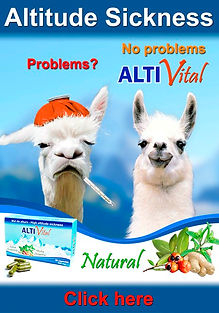PERU INFO
Scopri il Perù
Turismo
Prepara il tuo viaggio
Formalities
Citizens of the European Union, USA, Canada, etc. don't require a visa to enter Peru.
Visa requiered for some countries in Central America (Costa Rica, Cuba, El Salvador, Guatemala, Haiti, Honduras, Nicaragua, Rep. Dominicana), Europe (Albania, Armenia, Azerbaijan, Bosnia Herzegovina, Georgia, Turkey), Asia and Africa. Consult this page.
Your passport must be valid for at least 6 months after the scheduled return date.
Precautions
It is recommended to keep a copy of your passport with you, separate from the original document, which facilitate replacement of documents in case of loss or theft of passport.
IMPORTANT
Entrance in Machu Picchu is now limited to 2,500 visitors por day and Inca Trail limited to 400 by Unesco and it is essential to book in advance.
Also, the passport number presented at the entrance of the site should be the same as that of the reservation; if the passport is renewed between booking and the travel, will be denied entry without any possibility of negotiation.
Health
No vaccinations are required for Peru, however, it is recommended tetanus, polio and hepatitis A.
Yellow fever vaccination and antimalarial medication is recommended for travel to Amazonia.
Altitude sickness or "soroche"
It is similar to seasickness, symptoms include headache, nausea, fatigue and of course, shortness of breath upon exertion.
Some people feel nothing or lightheaded, others will be most affected. Some doctors recommend medications like Diamox (to be used with caution) or coramina glucose (not very effective).
The best option is coca in homeopathic doses. In the Andes it is necessary to drink lots of water, coca tea (infusion offered in hotels and restaurants), consuming sugar (sweets, chocolate, etc.) and make the slightest effort during the first days.
The altitude sickness is also rather psychological. Keep calm, relax and wait a moment, symptoms usually disappear within a few minutes, a few hours or ... a few days for some. People with heart or breathing problems should consult their doctor before coming to Peru.
Prepare your luggage
The climate of Peru is incredible diverse, including 28 of the 32 world climates. The desert coast has a very humid climate in Lima and dry elsewhere, in the Andes alternating hot and cold depending on the altitude and season, in the jungle prevails heat and humidity. To simplify, bring both light clothing such as pullovers, rain gear (just in case), comfortable walking shoes, swimsuit (it doesn't occupy much space), sunscreen, sunglasses, a hat or cap and an insect repellent (mainly for Nazca, Machu Picchu and jungle).
Peru has a temperate climate with only two seasons:
From April to October, it is the dry season in the Andes, with the lowest temperatures, 5° to 18° C (40º to 65º F) during the day and possible frost at night. On the coast it is winter with temperatures between 12º and 25º C (54 to 77º F).
From November to March, it is the rainy season in the Andes having the highest annual temperatures between 8º and 25º C (46º to 77º F) in this period, summer in the coast with temperatures between 16º and 28º C (60º to 83º F).
Above 4,500 m / 14,700 ft a.s.l. (outside conventional circuits) we can find intense cold to -20º C (0º F) in June / July and possibly snow.
The climate in the jungle is hot (22° to 38° C / 70º to 100º F) and humid all year, except in June / July with a possible friaje for a few days, a phenomenon of cold winds from the south with temperatures that can drop to 12° C (54º F).
Electricity
The electrical current in Peru is 220 V. The hotels are equipped sometimes with flat blade, sometimes flat and round chips. You will need to carry adapters.
Money
The Peruvian currency is the "nuevo sol", plural "nuevos soles", most commonly referred to just "sol", plural "soles", worth: 0.22€ or US$0.25 approx.
In 2014, the exchange rate is (changes every day and can have a variation of 10-15%):
1 US$=S /. 4 approx.
1 €=S /. 4.60 approx.
Dollar
Some shops, restaurants and hotels accept the US dollar (never for small purchases), but the change is usually unfavorable for the buyer.
Euro
Some craft stores accept the euro and is easily changed in casa de cambio (currency exchange).
ATMs
ATMs are easy to find in all coutry, sometimes with information in mutiple languages, accepting most of cards (Visa, MasterCard, Dinner, etc.).
ATMs limit amounts to S/.400 (100€ or US$120) or S/.500 (130€ or US$150) per operation, but you can make several withdrawals followed, obviously each withdrawal generates fees.
IMPORTANT
Damaged banknotes
Shops, banks and currency exchange DO NOT ACCEPT foreign banknotes (dollars, euros, etc.) that are not in good condition, very old, damaged (albeit slightly) or marked with ballpoint pen.
Budget
Peru is not as cheap as you can imagine. You may be surprised with some very low prices, such as handicrafts, cigarettes, while others will be very high as stamps or coffee.










